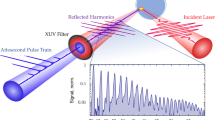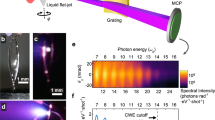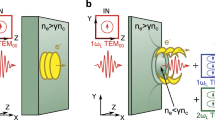Abstract
When a pulse of light reflects from a mirror that is travelling close to the speed of light, Einstein’s theory of relativity predicts that it will be up-shifted to a substantially higher frequency and compressed to a much shorter duration. This scenario is realized by the relativistically oscillating plasma surface generated by an ultraintense laser focused onto a solid target. Until now, it has been unclear whether the conditions necessary to exploit such phenomena can survive such an extreme interaction with increasing laser intensity. Here, we provide the first quantitative evidence to suggest that they can. We show that the occurrence of surface smoothing on the scale of the wavelength of the generated harmonics, and plasma denting of the irradiated surface, enables the production of high-quality X-ray beams focused down to the diffraction limit. These results improve the outlook for generating extreme X-ray fields, which could in principle extend to the Schwinger limit.
This is a preview of subscription content, access via your institution
Access options
Subscribe to this journal
Receive 12 print issues and online access
$209.00 per year
only $17.42 per issue
Buy this article
- Purchase on Springer Link
- Instant access to full article PDF
Prices may be subject to local taxes which are calculated during checkout






Similar content being viewed by others
References
Galayda, J. Linac coherent light source: Status and prospects. Proc. SPIE 5917, 591701 (2005).
Vartanyants, I.A. et al. Coherent x-ray scattering and lensless imaging at the European XFEL facility. J. Synch. Rad. 14, 453–470 (2007).
Hentschel, M. et al. Attosecond metrology. Nature 414, 509–513 (2001).
Neutze, R. et al. Potential for biomolecular imaging with femtosecond X-ray pulses. Nature 406, 752–757 (2000).
Pukhov, A. Relativistic plasmas: X-rays in a flash. Nature Phys. 2, 439–440 (2006).
Dromey, B. et al. High harmonic generation in the relativistic limit. Nature Phys. 2, 456–459 (2006).
Dromey, B. et al. Bright multi-KeV harmonic generation from relativistically oscillating plasma surfaces. Phys. Rev. Lett. 99, 085001 (2007).
Zepf, M., Dromey, B., Landreman, M., Foster, P. S. & Hooker, S. M. Bright quasi-phase-matched soft-X-ray harmonic radiation from argon ions. Phys. Rev. Lett. 99, 143901 (2007).
Paul, A. et al. Quasi-phase-matched generation of coherent extreme-ultraviolet light. Nature 421, 51–54 (2003).
Gordienko, S. et al. Relativistic Doppler effect: Universal spectra and zeptosecond pulses. Phys. Rev. Lett. 93, 115002 (2004).
Baeva, T., Gordienko, S. & Pukhov, A. Theory of high harmonic generation in relativistic laser interaction with overdense plasma. Phys. Rev. E 74, 046404 (2006).
Tsakiris, G. D., Eidmann, K., Meyer-ter-Vehn, J. & Krausz, F. Route to intense single attosecond pulses. New J. Phys. 8, 19 (2006).
Geissler, M. et al. 3D simulations of surface harmonic generation with few-cycle laser pulses. New J. Phys. 9, 218 (2007).
Schlenvoigt, H.-P. et al. A compact synchrotron radiation source driven by a laser-plasma wakefield accelerator. Nature Phys. 4, 130–132 (2008).
Gordienko, S. et al. Coherent focusing of high harmonics: A new way towards the extreme intensities. Phys. Rev. Lett. 94, 103903 (2005).
Zepf, M. et al. Role of the plasma scale length in the harmonic generation from solid targets. Phys. Rev. E 58, R5253–R5256 (1998).
Bulanov, S. V., Naumova, N. M. & Pegoraro, F. Interaction of an ultrashort, relativistically intense laser-pulse with an overdense plasma. Phys. Plasmas 1, 745–757 (1994).
Lichters, R., Meyer-ter-Vehn, J. & Pukhov, A. Short-pulse laser harmonics from oscillating plasma surfaces driven at relativistic intensity. Phys. Plasmas 3, 3425–3437 (1996).
Gibbon, P. Harmonic generation by femtosecond laser-solid interaction: A coherent water-window light source? Phys. Rev. Lett. 76, 50–53 (1996).
Plaja, L. et al. Generation of attosecond pulse trains during the reflection of a very intense laser on a solid surface. J. Opt. Soc. Am. B 15, 1904–1911 (1998).
Einstein, A. On the electrodynamics of moving bodies. Ann. Phys. Leipz. 17, 891 (1905).
Zepf, M. et al. High harmonics from relativistically oscillating plasma surfaces—a high brightness attosecond source at keV photon energies. Plasma Phys. Control. Fusion 49, B149–B162 (2007).
Quere, F. et al. Coherent wake emission of high-order harmonics from overdense plasmas. Phys. Rev. Lett. 96, 125004 (2006).
Thaury, C. et al. Plasma mirrors for ultrahigh-intensity optics. Nature Phys. 3, 424–429 (2007).
Quere, F. et al. Phase properties of laser high-order harmonics generated on plasma mirrors. Phys. Rev. Lett. 100, 095004 (2008).
Tarasevitch, A. et al. Transition to the relativistic regime in high order harmonic generation. Phys. Rev. Lett. 98, 103902 (2007).
an der Brügge, D. & Pukhov, A. Propagation of relativistic surface harmonics radiation in free space. Phys. Plasmas 14, 093104 (2007).
Wilks, S. C. et al. Absorption of ultra intense light pulses. Phys. Rev. Lett. 69, 1383–1386 (1992).
Norreys, P. et al. Efficient extreme UV harmonics generated from picosecond laser pulse interactions with solid targets. Phys. Rev. Lett. 76, 1832–1835 (1996).
Lichters, R. & Meyer-ter-Vehn, J. Multiphoton processes 1996. Inst. Phys. Conf. Ser. 154, 221–230 (1997).
Dromey, B. et al. The plasma mirror—a subpicosecond optical switch for ultrahigh power lasers. Rev. Sci. Instrum. 75, 645–648 (2004).
Carman, R. L., Forslund, D. W. & Kindel, J. M. Visible harmonics emission as a way of measuring profile steepening. Phys. Rev. Lett. 46, 29–32 (1981).
Rykovanov, S. et al. Intense single attosecond pulses from surface harmonics using the polarization gating technique. New J. Phys. 10, 025025 (2008).
Lambert, G. et al. Injection of harmonics generated in gas in a free-electron laser providing intense and coherent extreme-ultraviolet light. Nature Phys. 4, 296–300 (2008).
Schwinger, J. On gauge invariance and vacuum polarization. Phys. Rev. 82, 664–679 (1951).
Heisenberg, W. & Euler, H. Consequences of Dirac theory of the positron. Z. Phys. 98, 714–732 (1936).
Acknowledgements
M.Z. acknowledges support from the Royal Society. This work was supported by EPSRC and EU COST action MP0601.
Author information
Authors and Affiliations
Contributions
This experiment was carried out in the main by B.D., D.A., R.H. and Y.N. The simulations were carried out by S.G.R., with support from M.G. Experimental planning and data analysis was carried out by B.D. and M.Z.
Corresponding author
Supplementary information
Supplementary Information
Supplementary Informations (PDF 322 kb)
Rights and permissions
About this article
Cite this article
Dromey, B., Adams, D., Hörlein, R. et al. Diffraction-limited performance and focusing of high harmonics from relativistic plasmas. Nature Phys 5, 146–152 (2009). https://doi.org/10.1038/nphys1158
Received:
Accepted:
Published:
Issue Date:
DOI: https://doi.org/10.1038/nphys1158
This article is cited by
-
High-harmonic generation from a flat liquid-sheet plasma mirror
Nature Communications (2023)
-
Intense isolated attosecond pulses from two-color few-cycle laser driven relativistic surface plasma
Scientific Reports (2022)
-
Spatio-temporal characterization of attosecond pulses from plasma mirrors
Nature Physics (2021)
-
The X-Ray Emission Effectiveness of Plasma Mirrors: Reexamining Power-Law Scaling for Relativistic High-Order Harmonic Generation
Scientific Reports (2020)
-
Intense attosecond pulses carrying orbital angular momentum using laser plasma interactions
Nature Communications (2019)



